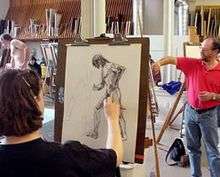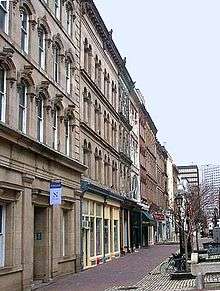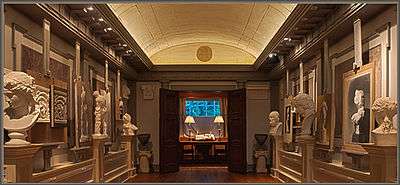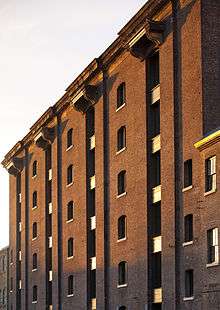Art school

An art school is an educational institution with a primary focus on the visual arts, including fine art, especially illustration, painting, photography, sculpture, and graphic design. Art schools are institutions with elementary, secondary, post-secondary or undergraduate, or part of a broad-based range of programs (such as the liberal arts and sciences). France's École des Beaux-Arts is, perhaps, the first model for such organized institution, breaking with a tradition of master and apprentice system when it was formed.
Art schools

Australia
- Victorian College of the Arts (University of Melbourne).
- RMIT University
- Monash University, Art Design and Architecture
- School of Arts, La Trobe University
- South Australian School of Arts, UniSA
- Adelaide Central School of Art[1]
- Sydney Art School[2]
- National Art School (NAS)[3]
- University of New South Wales Art & Design (previously College of Fine Arts)
- Sydney College of the Arts (University of Sydney)
- Queensland College of Art
- Australian National University School of Art
Canada

Universities and colleges
There are four independent art and design universities in Canada, all public institutions. They are Emily Carr University of Art and Design (Vancouver), NSCAD University (Halifax), OCAD University (Toronto), and Alberta College of Art and Design (Calgary).
Emily Carr University has the most active research program[4] among the four with over $15 million in research over the last five years. OCAD University's research intensity has reached $3.2 million in 2011/12.[5] All four schools teach in the major disciplines from painting through to new media and design. Over the last five years, Emily Carr has garnered the most of the major awards for students and alums across the country. The most recent RBC Painting Competition was won by Vanessa Maltese, a graduate of OCAD University.
NSCAD University was founded in 1887 by Anna Leonowens and other Halifax women. The school gained international prominence in the 1970s for innovation in conceptual art under the leadership of Garry Kennedy. In spite of its modest size, Art in America suggested in 1973 that NSCAD was "the best art school in North America", while more recently The Globe and Mail called it Canada's "most illustrious".[6][7]
Secondary schools (Toronto area)
Claude Watson School for the Arts and Karen Kain School of the Arts are intermediate-age public art schools in Toronto, Ontario. They are continued by the Claude Watson program at Earl Haig Secondary School and by the Etobicoke School of the Arts, Rosedale Heights School of the Arts, Wexford Collegiate School for the Arts, and the Catholic board Cardinal Carter Academy for the Arts.
In Brampton, Mayfield Secondary School's Regional Arts Program offers a public high school-level art school. St. Roch Catholic Secondary School and St. Thomas Aquinas Secondary School have Regional Arts Programs at the Catholic high school level.
France
In France, art schools have a long history. The oldest is Paris fine art school, established in 1682, but most present public art schools are over two centuries old too : Nancy (1708), Toulouse (1726), Rouen (1741), etc. Some of those schools were called academies and were prestigious institutions, devoted to the education of great painters or sculptors. Others were called "école gratuite de dessin" (free school for drawing), and were devoted to the education of arts and craft artists.
As of today, there is in France 45 national or territorial public high schools of art, that deliver bachelor (DNA) and Master (DNSEP) degrees. They don't belong to universities.
Germany
The Academy of Fine Arts Nuremberg (German: Akademie der Bildenden Künste Nürnberg) was founded in 1662 by Jacob von Sandrart and is the oldest art academy in German-speaking Central Europe. Fine and applied arts have since formed key sectors of learning, although emphasises have shifted in one direction or the other over the centuries. Today learning takes the form of interdisciplinary interaction, the dialogue between fine and applied disciplines. It is flanked by new degree courses and a new media technology study programme.
Indonesia
The first Art School in Indonesia was Universitaire Leergang voor Tekenleraren en Handenarbeit located in Bandung, part of Technical Faculty of Universiteit van Indonesie (Indonesian: Fakultas Teknik Universitas Indonesia). The school was initiated by Simon Admiraal (Art Teacher from Jakarta Lyceum), and Ries Mulder (Hollands Artist) in the year 1947. Now, the school is integrated to Institut Teknologi Bandung as Faculty of Art and Design, in the same location as previous school. Following the establishment of Universitaire Leergang, in 1950 ASRI (Indonesian Visual Art Academy) was opened in Jogjakarta, now ISI Jogjakarta. Currently there is a prominent Art School in every major Islands in Indonesia, following the establishment of ISI (Indonesian Art Institue) and ISBI (Indonesian Art and Culture Institute) in every major Islands/cities, like ISI Surakarta, ISI Denpasar, ISBI Aceh, ISBI Papua, ISBI Kalimantan, and ISBI Bandung. There are also prominent private art school/program in Indonesia namely Institut Kesenian Jakarta (Jakarta Arts Institute), visual arts program at Telkom University in Bandung, and also at Maranatha University.
The Netherlands
There are many famous art institutions in the Netherlands and many of them with long traditions. and had made great impact of the world thought the history. Royal Academy of art, The Hague founded year 1682 is the largest and oldest art institution in the Netherlands. Design Academy Eindhoven founded 1955 is today considered as one of the best design and art schools in the world. [8] Gerrit Rietveld Academie is another well known school founded in 1924 in Amsterdam with main focus on De Stijl and Bauhaus at that time.
Sweden
Art schools have had a history in Sweden since the first half of the 18th century. Students may attend the Royal Institute of Art, which got its start in 1735. Established in 1844 originally as a part-time art school for Sunday artisans, the University College of Arts, Crafts and Design known as "Konstfack" is an arts college offering bachelor's and master's degrees in ceramics, glass, textiles, metalworking, and more.
There are also tertiary art schools attached to universities in Gothenburg, Malmö and Umeå.
Bangladesh
United Kingdom
Perhaps those generally felt most applicable to the definition of 'art school' are the autonomous colleges or schools of art offering courses across both further and higher education boundaries, of which there are approximately eighteen, under the banner of United Kingdom Art & Design Institutions Association. Others, whose existence ties in indelibly with that of larger, non-discipline-specific universities (such as the Slade School of Art) exist. Most art schools of either orientation are equipped to offer opportunities spanning from post-16 to postgraduate level.
The range of colleges span from predominantly further education establishments to research-led specialist institutes. The University of the Arts London, for example, is a federally structured institution that comprises six previously independent schools situated in London. These include Camberwell College of Arts, Central Saint Martins, Chelsea College of Arts, London College of Communication, London College of Fashion, and Wimbledon College of Arts; others include The Slade School of Fine Art, The Royal College of Art and Goldsmiths College, University of London, which each grant undergraduate and postgraduate awards under one collegiate arm. The Royal College of Art with its degree-awarding arm and singular focus on postgraduate awards being a most singular exception.
Outside of London art schools in the UK include Arts University Bournemouth, Coventry School of Art and Design, University for the Creative Arts, Duncan of Jordanstone College of Art & Design, Edinburgh College of Art (part of University of Edinburgh), Glasgow School of Art, Gray's School of Art, Hereford College of Arts, Leeds College of Art, Liverpool School of Art (part of Liverpool John Moores University), Loughborough University School of Art and Design, Manchester School of Art (part of Manchester Metropolitan University), Norwich University of the Arts, Moray School of Art (University of the Highlands and Islands), The Northern School of Art and Plymouth College of Art and Design among others.
Since the 1970s, degrees have replaced diplomas as the top-tier qualification in the field.
In the case of wholly freestanding institutions, degree validation agreements in liaison with a university have long been the custom for Bachelor of Arts (Hons) level upward. There has been a general trend for all-encompassing universities to offer programs in the visual arts, and formerly independent art schools have merged with polytechnics and universities to offer such degrees. A notable exception to this is the City and Guilds of London Art School, an independent art school solely focused on fine art and related disciplines such as carving and conservation. A few art schools have taken on university status themselves, namely Arts University Bournemouth, University for the Creative Arts, University of the Arts London, and Norwich University of the Arts. While Courtauld Institute of Art, Leeds College of Art and Royal College of Art are recognised institutions - some with degree awarding powers.[9]
Most specialist institutions in the United Kingdom can trace their histories back to the nineteenth century or beyond, originating usually from government initiatives. Also there is Denver School of Performing Arts, which is a middle through high school.
United States

In the U.S., art and design schools that offer bachelor of fine arts or Master of Fine Arts degrees break down into basic types with some overlap and variations.
The most highly rated schools belong to a consortium formed in 1991 and called the Association of Independent Colleges of Art and Design (AICAD). These schools differ from for-profit career schools in that they require a strong component of liberal arts courses in addition to art and design courses, providing a well-rounded college degree.
There also are partnerships between art schools and universities such as School of the Art Institute of Chicago with Roosevelt University,[10] the New England School of Art and Design at Suffolk University, Art Institute of Boston at Lesley University, the Rhode Island School of Design with Brown University, Maryland Institute College of Art and Johns Hopkins University, the Corcoran College of Art and Design with The George Washington University, the School of the Museum of Fine Arts in conjunction with Tufts University, Tyler School of Art at Temple University, Parsons The New School for Design at The New School, or Herron School of Art at Indiana University.
There is one state-supported independent art school in the U.S., Massachusetts College of Art and Design. The first Art School in the U.S. is the Pennsylvania Academy of the Fine Arts (PAFA).
Cooper Union in New York City is among the most selective of art schools, admitting 4%, with every student on half scholarship. The Yale School of Art at Yale University offers only graduate classes in its two-year MFA programs. The Yale Daily News reported on Thursday, February 1, 2007 that the School had 1215 applications for its class of 2009 and would offer admission to fifty-five students.
Next up the scale in size for an art school would be a large art or design department, school, or college at a university. If it is a college, such as the College of Design at Iowa State University typically, it would contain programs that teach studio art, graphic design, photography, architecture, landscape architecture, interior design, or interior architecture, as well as art, design, and architectural history areas. Sometimes these are simply the schools of art, architecture, and design such as those at the College of Fine and Applied Arts at the University of Illinois at Urbana-Champaign or the Yale School of Art. With over 3,000 students, VCU School of the Arts at Virginia Commonwealth University is one of the largest art schools in the nation and is also has achieved the highest ranking ever for a public university.[11][12][13] Variation exists among art schools that are larger institutions, however, the essential element is that programs at universities tend to include more liberal arts courses and slightly less studio work, when compared to dedicated, but independent, schools of art.
The final and most common type of art school, a state supported or private program, would be at a university or college. It typically is a BA program, but also might be a BFA, MA, or MFA. These programs tend to emphasize a more general degree in art and do not require a major in a specific field, but might offer concentrations. A concentration is not accepted by some accrediting or professional organizations as being adequate preparation in some fields that would lead to success as a professional. This is the case for graphic design, where typically, the minimal degree is a BFA major in graphic design.
Many of the degree-offering institutions do not offer intense training in classical realism and academic painting and drawing. The Lyme Academy College of Fine Arts is considered a collegiate version of this educational model. This gap is filled by Atelier art schools (schools located inside an artist's studio) or in separate locations, such as the New York Academy of Art, the National Academy of Design, the New York Studio School, the Pennsylvania Academy of the Fine Arts (PAFA), established 1805, the Art Students League of New York, established in 1875.
Online art schools
In recent years a number of art schools have begun to offer some or all of their curricula online, which by nature, transcends national boundaries. Among these are The Art Institute of Pittsburgh Online and Academy of Art University.[14] As with on-ground schools, many of the majors involve computer-based work, such as compositions created in Photoshop, Illustrator, or 3D-Studio Max. Submission and review of these materials proceeds virtually identically for on-ground and online classes. When online courses require production of traditional drawings or other such materials, they usually are photographed or scanned for submission and review by instructors.
Art school culture
In contrast to the contemporary stereotype professional art and design education accredited by the National Association of Schools of Art and Design or offered by the members of the Association of Independent Colleges of Art and Design incorporates rigorous liberal arts and general education requirements so that students receive an authentic college or university degree.
See also
References
- ↑ http://www.acsa.sa.edu.au/ Official website
- ↑ http://sydneyartschool.com.au/ Official website
- ↑ "National Art School".
- ↑ research
- ↑ http://www.ocadu.ca/research.htm
- ↑ Levine, L. (July–August 1973). "The best art school in North America?". Art in America. 61 (4): 15.
- ↑ Milroy, Sarah (2 March 2013). "Why Canada's most illustrious art school is in crisis – and why we need to save it". The Globe and Mail.
- ↑ "Design Academy Eindhoven". Top Universities. 2015-07-16. Retrieved 2018-08-20.
- ↑ http://www.hefce.ac.uk/reg/register/search/
- ↑ Archived August 25, 2011, at the Wayback Machine.
- ↑ Archived August 29, 2011, at the Wayback Machine.
- ↑ "Virginia Commonwealth University Office of the Provost". Vcu.edu. 2013-11-19. Retrieved 2014-02-15.
- ↑ "VCUarts - Virginia Commonwealth University School of the Arts". Arts.vcu.edu. 2011-08-15. Retrieved 2014-02-15.
- ↑ "Academy of Art University Online Art School". Academy of Art University. Retrieved 2 November 2016.

